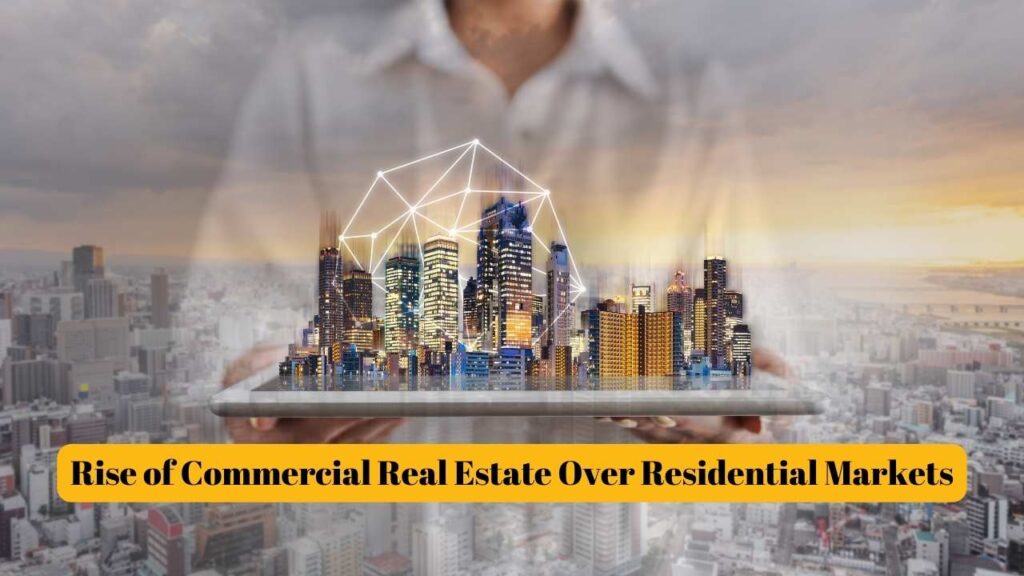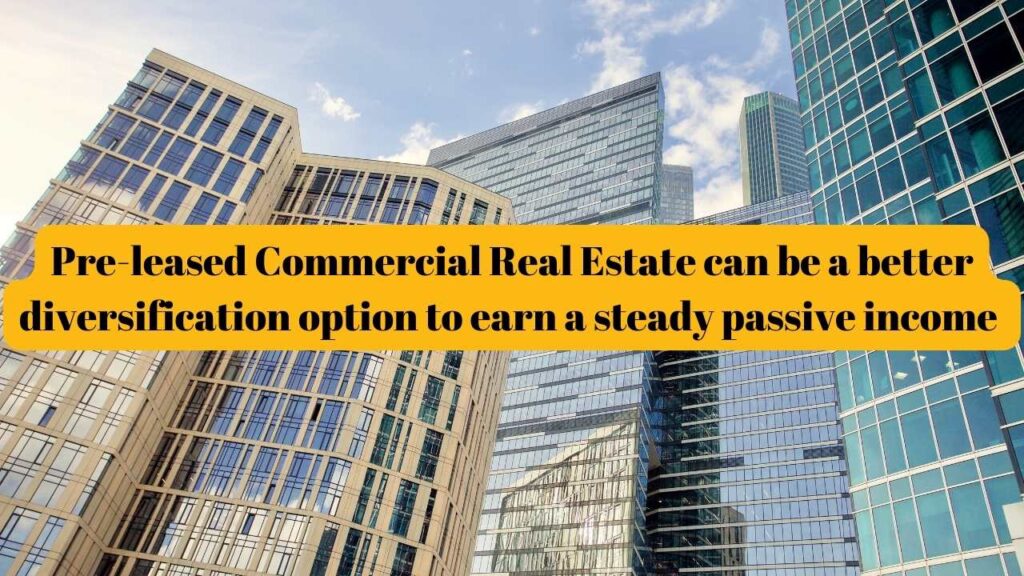The rise of commercial real estate over residential markets post-pandemic
The real estate environment has changed dramatically as a result of the epidemic. While the business and residential sectors deal with the fallout, an unexpected tendency emerges: the rise of commercial real estate, CRE has recovered more quickly than the residential market. Growth in the economy and returns on investments are greatly aided by the commercial real estate sector. Commercial real estate assets have historically yielded an average return on investment of 9.5%, which is comparable to major equities indices.
This article goes into this phenomenon, examining the fundamental drivers of commercial real estate growth in the post-pandemic era. We analyze how workplace culture has changed and how the e-commerce revolution has affected retail stores, office buildings, and industrial complexes. We discover the detailed narrative underlying the various paths of these main real estate industries by assessing difficulties, opportunities, and investment implications.
Factors Driving Growth in Post-Pandemic Commercial Real Estate
Post-pandemic commercial property expansion is driven by a confluence of variables changing how people work, shop, and interact.
Change in Work Culture
- Remote Work Dynamics: The extensive use of remote work during the pandemic has shifted perspectives of typical office arrangements. Companies are increasingly adopting remote and hybrid work methods, prompting a rethinking of office space requirements.
- Office Space Adaptation: To meet tenants’ changing demands, industrial real estate developers are revamping office spaces to encourage flexibility, cooperation, and employee well-being. It involves including elements like flexible layouts, community areas, and improved ventilation systems to provide a secure and efficient atmosphere.
- Rethinking Location Preferences: As remote work has become more popular, employees have reconsidered their preferred locations, resulting in greater demand for suburban or remote office spaces that provide a better work-life balance.
Retail’s Resurgence
- Adaptive Reuse of Commercial Spaces: Properties vacant from retail operations are being repurposed and rethought for various uses, including offices, apartments, theaters, and mixed-use projects. This adaptive reuse technique revitalizes lagging retail areas and opens new prospects for commercial real estate owners.
- Rise of Participatory Retail: To draw in and keep customers, retailers are investing in immersive, interactive, and customized shopping concepts. Among the non-traditional forms of brick-and-mortar commerce are pop-up shops, flagship retail outlets, showrooming, and carefully planned events.
- Focus on Sustainability and Wellness: To stand out in an increasingly crowded sector, retail developers are stressing sustainability and wellness activities that encourage responsibility for the environment, health, and well-being. Effective construction methods, ecologically friendly design components, and health-focused facilities are all incorporated into retail buildings to improve customer satisfaction.
E-Commerce Boom
- Increased Warehouse Demand: The rapid move to online shopping has increased the requirement for effective warehouse and delivery facilities. Companies are looking for strategically positioned industrial real estate sites that help with faster order processing and delivery to suit the rising needs of e-commerce clients.
- Expansion of Last-Mile Delivery Network: Last-mile distribution network growth has been spurred by the emergence of immediate and following-day delivery services. It has increased demand for smaller industrial sites in metropolitan areas to allow timely delivery and lower transportation expenses.
- Infrastructure for Logistics: Investors are flooding the market with money to fund the construction of automated warehouses, cutting-edge technology, and fulfillment centers to support the explosive expansion of e-commerce.
Innovation and Technology
- Adoption of Innovative Building Solutions: To increase operational effectiveness, lower energy costs, and boost tenant satisfaction, commercial property developers are progressively incorporating smart building technology. It entails maximizing building performance and improving occupant comfort via IoT sensors, building control systems, and machine learning platforms.
- Growth of Data Centers: The development of big data, cloud computing, data analysis, and virtual reality has increased the demand for data center infrastructure. Commercial property investors are profiting from this trend by building or buying data center facilities to meet the changing needs of technology corporations and digital enterprises.
- Emergence of Technology Hubs: Major cities worldwide are seeing the rise of technology hubs and creative districts that attract tech companies, universities, and venture capitalists. These lively ecosystems encourage cooperation, innovation, and entrepreneurship, resulting in increased demand for commercial property sites in key locations.
These thorough insights show the diverse nature of the drivers driving post-pandemic rise of commercial real estate, emphasizing the intricate interaction of altering market dynamics, technology innovation, and changing customer preferences.
Challenges and Opportunities in Post-Pandemic Commercial Real Estate
Navigating the post-pandemic world poses problems and opportunities for the rise of commercial real estate players.
Office Space Dynamics
- Challenge: Potentially oversupply in some sectors if corporations reduce office footprints or implement remote work arrangements.
- Opportunity: Redeveloping and repurposing outdated office facilities into mixed-use complexes, coworking locations, or flexible office models to satisfy changing tenant demands.
Industrial Real Estate
- Challenge: Abundance in some places when demand for warehouse and distribution hubs peaks, resulting in higher competition and perhaps lower rates.
- Opportunity: Invest in specialist commercial properties such as freezing rooms, e-commerce fulfillment centers, and logistics hubs near key transportation hubs to benefit from rising demand for professional real estate assets.
Retail Transformation
- Challenge: Responding to changing consumer habits and tastes, such as the advent of internet shopping and experiential retail ideas.
- Opportunity: Repositioning retail assets using adaptive reuse techniques, experiential retail services, and innovative placemaking activities to increase foot traffic and improve overall shopping experiences.
Sustainability and Resilience
- Challenge: Mitigating hazards associated with climate change while tightening regulatory control over environmental resilience and sustainability requirements.
- Opportunity: Including resilience techniques, renewable energy sources, and green construction methods in commercial real estate projects can save operating costs, increase asset value, and lessen the risk associated with climate change.
Capital Market Volatility
- Challenge: Managing financial market volatility, interest rate swings, and inflationary pressures.
- Opportunity: Diversifying investment portfolios, making opportunistic purchases, and forming strategic alliances to capitalize on market disruptions and unlock value in assets that are in trouble.
Supply Chain Disruptions
- Challenge: The challenge is to manage supply chain interruptions such as building material shortages, workforce constraints, and transportation delays.
- Opportunity: Diversifying supply chains, outsourcing manufacturing activities, and investing in resilient logistics systems to reduce supply chain risks and increase supply chain agility.
Workforce Trends
- Challenge: Attracting and keeping people in a competitive labor market, as well as dealing with workplace safety, wellness, and wellness problems.
- Opportunity: Implement telecommuting, remote work regulations, and employee wellness initiatives to increase staff productivity, happiness, and retention.
Technological Integration
- Challenge: Keeping up with rapid technological and digital developments, including cybersecurity hazards and data privacy issues.
- Opportunity: Use smart building technology, Internet of Things (IoT) devices, and data analytics systems to improve building performance, increase tenant satisfaction, and generate new income streams through additional services.
Investors in commercial real estate may negotiate the intricacies of the post-pandemic environment and set themselves up for resilience and long-term success by tackling these obstacles and grasping possibilities.
Conclusion
To summarize, the post-pandemic age offers an evolving environment for the rise of commercial real estate, marked by a mix of difficulties and possibilities. When the industry is reshaped by changes in work culture, online shopping dynamics, and technological innovation, stakeholders must also deal with issues such as changing office spaces, retail, and sustainability requirements.
However, by embracing flexibility, creativity, and adaptability, commercial real estate shareholders, developers, and occupiers may capitalize on emerging trends, rethink established models, and position themselves for long-term development and success in a quickly changing market landscape. The trip ahead requires strategic forethought, ingenuity, and a willingness to embrace change to create long-term value. Visit our website at BHIVE.






No comment yet, add your voice below!